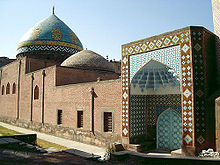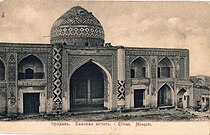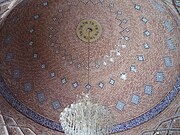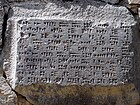This is an old revision of this page, as edited by Parishan (talk | contribs) at 06:46, 18 February 2015 (because the Armenian name bears zero historical relevance for this landmark; there has never been an Armenian-speaking Shia community in Yerevan that would use this name to refer to the mosque). The present address (URL) is a permanent link to this revision, which may differ significantly from the current revision.
Revision as of 06:46, 18 February 2015 by Parishan (talk | contribs) (because the Armenian name bears zero historical relevance for this landmark; there has never been an Armenian-speaking Shia community in Yerevan that would use this name to refer to the mosque)(diff) ← Previous revision | Latest revision (diff) | Newer revision → (diff) For other uses, see Blue Mosque (disambiguation).| Blue Mosque Template:Lang-hy | |
|---|---|
 | |
| Religion | |
| Affiliation | Islam |
| District | Kentron |
| Rite | Twelver Shia |
| Ecclesiastical or organizational status | Mosque |
| Location | |
| Location | |
| Architecture | |
| Style | Islamic |
| Completed | 1764-68 |
| Specifications | |
| Minaret(s) | 1 |
| Minaret height | 24 |
The Blue Mosque (Template:Lang-az; Template:Lang-fa, Masjed-e Kabud; Template:Lang-hy, Kapuyt Mzkit), is a mosque in Yerevan, Armenia. During the Soviet era, because of atheist policy, the Mosque stopped its services and became the Museum of Yerevan. After the independence of Armenia, with the support from Iranian government, the premises again started acting as a Mosque.
History
The Yerevan region had been under the control of various Muslim rulers since the incursions of Timur in the 14th century. From the second third of the 18th century, it had been a province of Iran (ruled successively by Nadir Shah, Karim Khan Zand and the Iranian Qajar Dynasty), before it fell to the Russian empire in 1827.
For the mosque's construction, various dates from the mid-18th century are cited in literature. As reported by 19th-century traveller H.F.B. Lynch, the Blue Mosque was commissioned to be built during the reign of Iranian ruler Nadir Shah (1736–47) by Husayn Ali Khan. George Bournoutian names Husayn Ali Khan as the patron of the building, but places his reign in the years 1762-83. According to Vladimir M. Arutyunyan et al. construction started in 1760 and was completed under Husayn Ali Khan in 1764-68.
The building was the main congregational mosque for the city. When Yerevan was captured by Russia in 1827 it was, according to the cataster drawn up by the Russians, the largest of its eight functioning mosques. The building consisted of the main prayer hall, a library, and a madrasa with 28 cells, all organised around a courtyard, with the overall complex occupying 7,000 square metres of land. There is a single minaret at the main portal, in keeping with contemporaneous mosques, and there is no evidence that there were more minarets.
Due to the secularist policies of the Soviet government, religious services at the Blue Mosque were stopped and in 1931 it was used to house the Museum of the City of Yerevan. In the latter half of the 1990s the mosque underwent a heavy restoration, funded by Iran, that U.S. State Department employee and foreign service officer Brady Kiesling criticised for being aesthetically damaging in his travel book. The restoration raised concerns in Azerbaijan as the mosque was presented as an Iranian mosque, which in Azerbaijan is considered the heritage of the once large Azerbaijani community of Armenia. Islamic religious services have now resumed within the Blue Mosque, which is the only operating mosque in Armenia. The Museum of the City of Yerevan is now housed in a purpose-built building on another site.
Gallery
-
 The Blue Mosque in Yerevan, view from the courtyard towards the prayer hall (photo F. Sarre, 1897)
The Blue Mosque in Yerevan, view from the courtyard towards the prayer hall (photo F. Sarre, 1897)
-
 The "Khan's Mosque" in Yerevan
The "Khan's Mosque" in Yerevan
-
The entrance and the dome
-
 Secondary entrance of the Blue Mosque in Yerevan, added in the late 19th century to the original plan (pictured after the recent renovation)
Secondary entrance of the Blue Mosque in Yerevan, added in the late 19th century to the original plan (pictured after the recent renovation)
-
 A modern view from the courtyard towards the prayer hall
A modern view from the courtyard towards the prayer hall
-
Minaret of the Blue Mosque
-
Closer view of the dome
-
 Interior view of the dome
Interior view of the dome
See also
Notes
- http://www.parev.am/PICTURES/9aYerevan/03.html
- Lynch, H.F.B. (1901). Armenia, Travels and Studies, Volume 1. London: Longmans. pp. 213–214.
- Bournoutian, George (1992). The Khanate of Erevan Under Qajar Rule, 1795-1828. Costa Mesa, CA: Mazda Publishers. p. 45.
- Template:Ru icon Arutyunyan, Vladimir M (1968). Ереван (Yerevan). Moscow: Izdvo litry po stroitelstvu. p. 31.
- Markus Ritter, "Moscheen und Madrasabauten" in Iran 1785–1848: Architektur zwischen Rückgriff und Neuerung (Leiden, Boston: Brill 2006), pp. 363–366, pl. 163-164, 202f.
- Hovhannessian, Hrant A (1986). The Museums of Yerevan. Yerevan: Hayastan Publishing. pp. 19–21.
- http://www.youtube.com/watch?v=hXCejbKwlAM
- Kiesling, Brady (2005). Rediscovering Armenia, 2nd edition. Yerevan: Matit. p. 37.
- http://www.azadliq.org/content/article/2032531.html
